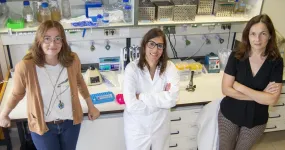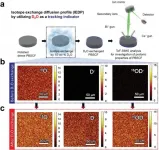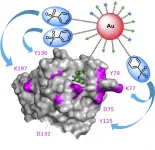(Press-News.org) Two model studies document the probability of climate tipping in Earth subsystems. The findings support the urgency of restricting CO2 emissions as abrupt climate changes might be less predictable and more widespread in the climate system than anticipated. The work is part of the European TiPES project, coordinated by the University of Copenhagen, Denmark but was conducted by Professor Michael Ghil, Ecole Normale Supérieure, Paris, France and coauthours from The Royal Meteorological Institute of Belgium and Parthenope University of Naples, Italy.
Tipping could be imminent
It is often assumed climate change will proceed gradually as we increase the amounts of CO2 in the atmosphere. Over the last 15 years, however, it has become increasingly clear that the Earth's climate system or subsystems thereof - such as sea ice cover, monsoon systems, and ocean currents - might shift abruptly and with little warning as CO2 levels go up. This is known as climate tipping.
Two studies from the European TiPES project now add to the evidence that tipping could be imminent and might be more widespread in the climate system than usually anticipated.
El Ninõ tips weather-system
In the first study, the authors show in a coupled ocean-atmosphere model how the mid-latitude wind systems over Europe and North America has a probability to tip between different types of behaviour (or different regimes, as climate scientists say) depending on the strength of an El Niño. In other words, the climate phenomenon El Niño - during which heat builds up in the surface layers of the eastern tropical Pacific Ocean - determines whether the mid-latitude wind system in the U.S.A. will be more or less likely to shift abruptly between one regime and another.
Such probabilistic climate tipping complicates prediction, which is generally based on the assumption that climate systems change gradually in a more predictable manner. The findings, - co-authored with Stéphane Vannitsem and Jonathan Demaeyer from the Royal Meteorological Institute of Belgium and published in Journal of Advances in Modeling Earth Systems, thus explain why the patterns of precipitation and temperature during and after an El Niño, have been difficult to predict with accuracy up till now.
Tipping the Gulf Stream
The other result concerns rate-induced tipping. This kind of climate tipping takes place not because a certain threshold level is reached, like a CO2 level in the atmosphere, but rather because the rate of change is too fast for the system to evolve gradually.
The study - co-authored with Stefano Pierini from the Parthenope University of Naples and published in Scientific Reports, finds rate-induced tipping in a simplified model of the wind-driven ocean circulation for the first time. In this model study, the Gulf Stream - which distributes heat to the North Atlantic and plays an important role in keeping the temperatures in Western Europe relatively mild - tips between regimes when CO2 is introduced at a rapid rate into the model.
A real risk
Such a result is highly relevant as levels of CO2 in the atmosphere currently go up at an unprecedented rate. If the Gulf Stream eventually tips in this rate-induced manner, Western Europe could experience rather abrupt changes to its climate.
"These results indicate that climate tipping is an imminent risk in the Earth System. Even the safe operating space of 1.5 or 2.0 degrees above present generally assumed by the IPCC might not be all that safe. According to the precautionary principle, we must consider abrupt and irreversible changes to the climate system as a real risk - at least until we understand these phenomena better," says Professor Michael Ghil.
The TiPES project is an EU Horizon 2020 interdisciplinary climate science project on tipping points in the Earth system. 18 partner institutions work together in more than 10 countries. TiPES is coordinated and led by The Niels Bohr Institute at the University of Copenhagen, Denmark and the Potsdam Institute for Climate Impact Research, Germany.
The TiPES project has received funding from the European Horizon 2020 research and innovation program, grant agreement number 820970.
INFORMATION:
This news release is about two studies.
1)
Pierini, S., and M. Ghil, 2021: Climate tipping points induced by parameter drift: an excitable system study, Scientific Reports, 11, 11126, doi:10.1038/s41598-021-90138-1, https://rdcu.be/clp5V.
AND
2)
Vannitsem, S., J. Demaeyer, and M. Ghil, 2021: Extratropical low-frequency variability with ENSO forcing: A reduced-order coupled model study,
Journal of Advances in Modeling Earth Systems, 13, e2021MS002530, doi:10.1029/2021MS002530.
Streptococcus pneumoniae is a major human pathogen and a leading cause of several infectious diseases including pneumonia, the third-leading cause of death in Portugal. In Europe, S. pneumoniae is the most common cause of community-acquired bacterial pneumonia in adults. Still, very little is known about its colonization within this age group. A team of researchers from ITQB NOVA has now taken a crucial step to clarify the dynamics of carriage of this bacterium in adults.
This bacterium, also known as pneumococcus, can asymptomatically colonize the human upper respiratory tract. Colonization not only precedes diseases but is also essential for transmission. Even ...
In 2011, scientists confirmed a suspicion: There was a split in the local cosmos. Samples of the solar wind brought back to Earth by the Genesis mission definitively determined oxygen isotopes in the sun differ from those found on Earth, the moon and the other planets and satellites in the solar system.
Early in the solar system's history, material that would later coalesce into planets had been hit with a hefty dose of ultraviolet light, which can explain this difference. Where did it come from? Two theories emerged: Either the ultraviolet light came from our then-young sun, or it came from a large nearby star in the sun's stellar nursery.
Now, researchers from the lab of Ryan Ogliore, assistant professor of physics in Arts ...
The neocortex is a layered structure of the brain in which neurons are arranged parallel to each other. This organization is critical for healthy brain function. A team of researchers from Charité - Universitätsmedizin Berlin have uncovered two key processes that direct this organization. Reporting in Science Advances*, the researchers identify one crucial factor which ensures the timely movement of neurons into their destined layer and, subsequently, their final parallel orientation within this space.
The neocortex is the outer region of the brain. It is responsible for cognitive functions such as language, decision-making, and ...
A research team, led by Professor Guntae Kim in the School of Energy and Chemical Engineering at UNIST has introduced an innovative way to quantify proton kinetic properties of triple (H+/O2?/e?) conducting oxides (TCOs) being a significant indicator for characterizing the electrochemical behavior of proton and the mechanism of electrode reactions.
Layered perovskites have recently received much attention as they have been regarded as promising cathode materials for protonic ceramic fuel cells (PCFCs) that use proton conducting oxide (PCO) as an electrolyte. Therefore, quantitative characterization of the proton kinetics in TCO can be an important indicator providing a scientific ...
Psychologists from UNSW Sydney have developed a new face identification ability test that will help find facial recognition experts for a variety of police and government agencies, including contract tracing.
The Glasgow Face Matching Test 2 [GFMT2] targets high-performing facial recognition individuals known as super-recognisers, who have an extraordinary ability to memorise and recall faces.
The type of professional roles that involve face identification and that could benefit from the test include visa processors, passport issuers, border control officers, ...
Cells play a precise game of telephone, sending messages to each other that trigger actions further on. With clear signaling, the cells achieve their goals. In disease, however, the signals break up and result in confused messaging and unintended consequences. To help parse out these signals and how they function in health -- and go awry in disease -- scientists tag proteins with labels they can follow as the proteins interact with the molecular world around them.
The challenge is figuring out which proteins to label in the first place. Now, a team led by researchers from Tokyo University of Agriculture and Technology (TUAT) has developed a new approach to identifying and tagging the specific proteins. They published their results on June 1 in Angewandte ...
AUSTIN, Texas -- A diagnostic tool called the MasSpec Pen has been tested for the first time in pancreatic cancer patients during surgery. The device is shown to accurately identify tissues and surgical margins directly in patients and differentiate healthy and cancerous tissue from banked pancreas samples. At about 15 seconds per analysis, the method is more than 100 times as fast as the current gold standard diagnostic, Frozen Section Analysis. The ability to accurately identify margins between healthy and cancerous tissue in pancreatic cancer surgeries can give patients the greatest chance of survival.
The results, by a team from ...
TORONTO, July 6, 2021 - What's stressing out bumblebees? To find out, York University scientists used next-generation sequencing to look deep inside bumblebees for evidence of pesticide exposure, including neonicotinoids, as well as pathogens, and found both.
Using a conservation genomic approach - an emerging field of study that could radically change the way bee health is assessed - the researchers studied Bombus terricola or the yellow-banded bumblebee, a native to North America, in agricultural and non-agricultural areas. This new technique allows scientists to probe for invisible stressors affecting bees.
Like many pollinators, the yellow-banded bumblebee ...
A collaborative research project between the five First Nations of the Nanwakolas Council of B.C. and Simon Fraser University is contributing to conservation efforts of the iconic western redcedar tree.
New research in the Journal of Ethnobiology highlights concerns about the long-term sustainability of this culturally significant resource. Researchers found that western redcedar trees suitable for traditional carving are generally rare. Some important growth forms, such as large, spectacular trees appropriate for carving community canoes, are nearly extirpated from ...
WASHINGTON, July 6, 2021 -- Emitted as gases from certain solids or liquids, volatile organic compounds (VOCs) include a variety of chemicals. Many of these chemicals are associated with a range of adverse human health effects, from eye, nose, and throat irritation, to liver, kidney, and central nervous system damage.
The ability to detect VOCs in air samples simply, quickly, and reliably is valuable for several practical applications, from determining indoor air quality to screening patients for illnesses.
In Review of Scientific Instruments, by AIP ...







